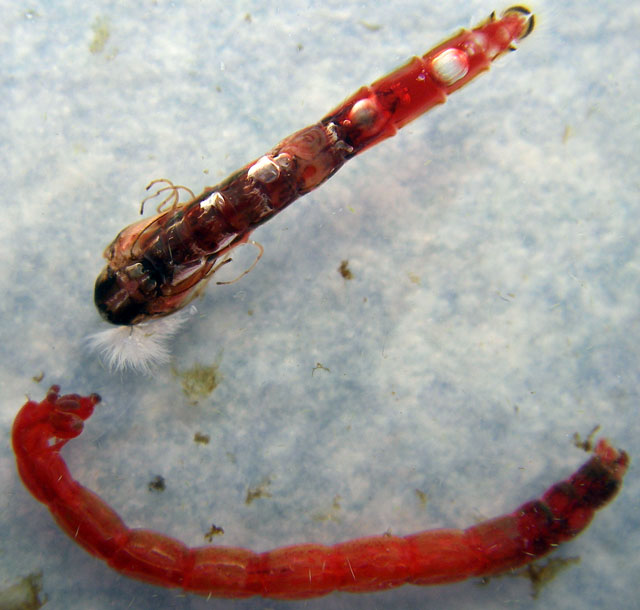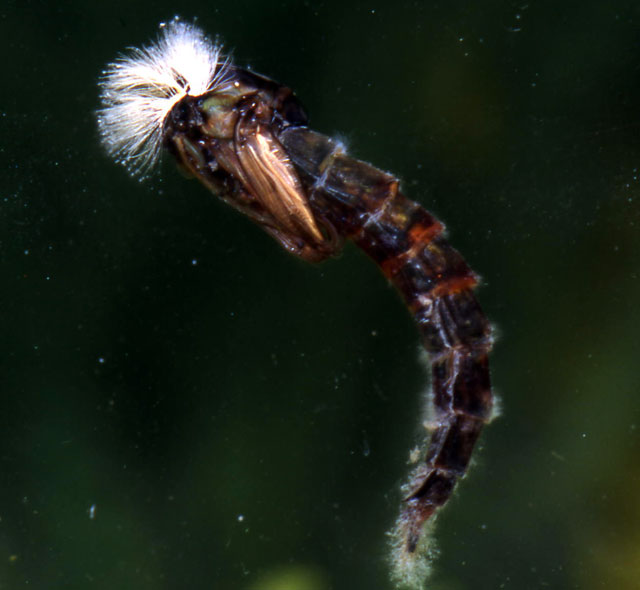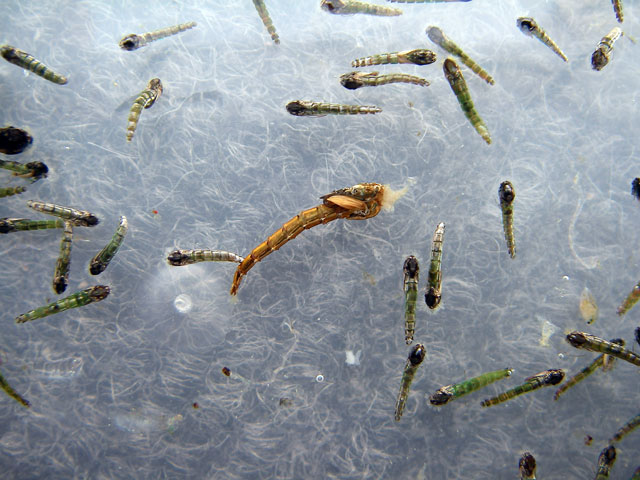
Hatches - Chironomid Fever
stillwater fly fishers have good reason to get excited about the start of each and every fishing season as the year always begins with the intense emergences of chironomids. Those that have mastered this hatch will undoubtedly get a good case of chironomid fever, which is a good thing. Chironomids or midges offer the most prolonged and prolific emergences of all the aquatic insects found in both lakes and streams. Their species diversity and incredible abundance makes them one of the most staple food sources of trout and other game fish. The key to mastering this important hatch is a solid understanding of the chironomid life cycle. Knowing specific details about each phase of its life history determines where and how to present proper imitations.
 Chironomids undergo a complete metamorphosis which includes egg, larval, pupal and adult phases. Some species exist in the larval stage for up to 2 years before transforming into the pupa. Most chironomid larvae are found living in the benthic zone (bottom of the lake) between 5 and 25 feet in depth. However, some species are able to withstand very harsh environmental conditions and that allows the larvae to live at considerable depths and in water bodies exhibiting very poor water quality. It is not uncommon to see good populations of larvae living at the bottom of the lake at depths of 30 to 50 feet. Typically, the larvae burrow into or inhabit tubes built in the mud or other bottom substrate. Larvae that live in oxygen poor or almost anoxic conditions exhibit a blood red colouration due to the presence of a haemoglobin-like fluid with the circulatory system. Other common chironomid larval colours include shades of green and combinations of green and maroon. Chironomid larvae feed on detritus or decomposing plant material. Larvae are poor swimmers but they do leave the protection of their burrows or tubes to feed. Trout typically root out the larvae from their benthic homes. Larvae that over-winter will often move from shallower water to deeper depths and re-establish their burrows or tubes. These migrations occur late in the fall and at that time become much more vulnerable to foraging trout.
Chironomids undergo a complete metamorphosis which includes egg, larval, pupal and adult phases. Some species exist in the larval stage for up to 2 years before transforming into the pupa. Most chironomid larvae are found living in the benthic zone (bottom of the lake) between 5 and 25 feet in depth. However, some species are able to withstand very harsh environmental conditions and that allows the larvae to live at considerable depths and in water bodies exhibiting very poor water quality. It is not uncommon to see good populations of larvae living at the bottom of the lake at depths of 30 to 50 feet. Typically, the larvae burrow into or inhabit tubes built in the mud or other bottom substrate. Larvae that live in oxygen poor or almost anoxic conditions exhibit a blood red colouration due to the presence of a haemoglobin-like fluid with the circulatory system. Other common chironomid larval colours include shades of green and combinations of green and maroon. Chironomid larvae feed on detritus or decomposing plant material. Larvae are poor swimmers but they do leave the protection of their burrows or tubes to feed. Trout typically root out the larvae from their benthic homes. Larvae that over-winter will often move from shallower water to deeper depths and re-establish their burrows or tubes. These migrations occur late in the fall and at that time become much more vulnerable to foraging trout.
There are several key points to consider when fishing the chironomid larva. Presentations should be fished as close to the lake bottom as possible as that is where the majority of larvae are found. Because some species over winter in the larval stage, they are a good pattern to try in both early spring and late fall. Larvae are poor swimmers so imitations of them should be fished very slowly or with no movement other than wave action while suspended under a strike indicator.
 When mature, the chironomid larvae will transform into the pupal stage. This change occurs within the larval burrow or tube at the bottom of the lake. The newly developed pupae break out of the old larval tube and are now ready to rise to the surface of the lake. Water temperature now plays a major factor in determining when and how fast the pupae travel to the surface to complete the emergence process. Often, large numbers of pupae will stage with a couple feet of the lake bottom as they await final development and appropriate water temperatures. This staging can last for several days and during this period, the pupae are extremely vulnerable to predation by trout or other fish species. This scenario explains one of the main reasons why we can have tremendous pupal fishing and not ever see an adult actually emerge. There is no turning back once the pupae begin the ascent to the surface. Gases accumulate beneath their shuck and that helps elevate them up through the water column. As the pupae ascend, they become shinier or more silver-like in appearance. Upon reaching the surface film, a split develops in the thorax of the pupae and the adult form emerges. Almost immediately the winged adult flies off to nearby shoreline vegetation. In most situations, trout prefer to eat the pupae deeper rather than higher in the water column. This is especially true in very clear lakes where fish are more vulnerable to predators such as ospreys and loons. Trout can also be very particular as to the actual depth zone that they will eat the emerging pupae. For example, chironomid pupae may be emerging from water that is 18 feet deep but the trout are focussed on the pupae that are passing through the 14 to 15 foot zone of the water column. Presenting pupal patterns above or below this narrow feeding zone results in far less interest by the trout. Therefore, knowing the depth one is fishing is very important and thus the reason why depth sounders are a valuable asset in this type of fishing. A good rule to follow is to start presenting pupal patterns within about a foot of the lake bottom and then gradually moving higher in the water column until the right feeding depth is located. One can now see why the use of strike indicators is such an effective way to suspend pupal and larval patterns at very precise depth zones.
When mature, the chironomid larvae will transform into the pupal stage. This change occurs within the larval burrow or tube at the bottom of the lake. The newly developed pupae break out of the old larval tube and are now ready to rise to the surface of the lake. Water temperature now plays a major factor in determining when and how fast the pupae travel to the surface to complete the emergence process. Often, large numbers of pupae will stage with a couple feet of the lake bottom as they await final development and appropriate water temperatures. This staging can last for several days and during this period, the pupae are extremely vulnerable to predation by trout or other fish species. This scenario explains one of the main reasons why we can have tremendous pupal fishing and not ever see an adult actually emerge. There is no turning back once the pupae begin the ascent to the surface. Gases accumulate beneath their shuck and that helps elevate them up through the water column. As the pupae ascend, they become shinier or more silver-like in appearance. Upon reaching the surface film, a split develops in the thorax of the pupae and the adult form emerges. Almost immediately the winged adult flies off to nearby shoreline vegetation. In most situations, trout prefer to eat the pupae deeper rather than higher in the water column. This is especially true in very clear lakes where fish are more vulnerable to predators such as ospreys and loons. Trout can also be very particular as to the actual depth zone that they will eat the emerging pupae. For example, chironomid pupae may be emerging from water that is 18 feet deep but the trout are focussed on the pupae that are passing through the 14 to 15 foot zone of the water column. Presenting pupal patterns above or below this narrow feeding zone results in far less interest by the trout. Therefore, knowing the depth one is fishing is very important and thus the reason why depth sounders are a valuable asset in this type of fishing. A good rule to follow is to start presenting pupal patterns within about a foot of the lake bottom and then gradually moving higher in the water column until the right feeding depth is located. One can now see why the use of strike indicators is such an effective way to suspend pupal and larval patterns at very precise depth zones.
There will also be many days when the trout are feeding much more aggressively and, in these situations, a floating line and long leader is a very effective way to present the chironomid pupa. This method works best in water less than about 20 feet in depth. Use a leader that is approximately 25% longer than the depth being fished. This ensures the fly can be retrieved through the deepest depth zones. The standard procedure for this technique is to cast out, wait for the fly to sink to within a couple of feet of the bottom and then begin a very slow hand twist retrieve. One has to use a countdown to determine where the fly is in the water column. If the fly snags up on the retrieve then reduce the amount of time the fly is allowed to sink before beginning the next retrieve. Bead-headed or weighted patterns sink faster and will stay in the desired depth zone as the fly is retrieved. This technique passes the chironomid horizontally through the water column but at a very slow rate which gives the trout lots of time to see it.
Deep water chironomid pupal emergences often occur during the early to mid-summer months. These are hatches occurring at depths of greater than about 30 feet. The full sinking line technique is very effective in these situations. Once anchored, the angler casts out a fast sinking line exactly the depth of the water being fished. The fly line is allowed to sink until it is straight up and down or perpendicular to the surface of the lake. A very slow hand twist retrieve is initiated which brings the pupa pattern up through the water column. The trout will often take fly within 6 feet of the bottom or within 6 feet of the surface as the fish follow the fly up from the deep water. This can be a very exciting technique to fish as the strikes are often hard enough to almost pull the rod from your hands. Remember to keep your rod tip pointed right at the surface film so that a good strike set can be completed.
It is quite common for several species of chironomids to be emerging at the same time. This offers the trout a choice of colour and size. Anglers must always keep in mind that trout can differentiate colours and that the fish will often switch from one colour or species of chironomid to another during the daily emergence period. One must keep a close eye on the water to detect the changing emergence patterns. A small aquarium net allows one to capture pupae and emerging adults which can be closely examined to better match pupal size and colour. A throat pump can also be a valuable tool in helping determine what colour and size of pupae the fish are actually eating. The throat pump samples the last food items that are still in the oesophagus or throat of the fish. It's best to sample only fish longer than 12 to 14 inches in length as their oesophagus will be developed enough to accept the sampling tube.
 Trout also feed on the adult chironomid either as the newly emerged or the egg laying female as it returns to the water to complete the life cycle. Riseforms will vary from quick splashy takes to very subtle head and tail sips. Individual trout will feed in a particular direction and one can anticipate where and when it will rise next. An adult pattern can be cast and retrieved ahead of the feeding fish with surprising results.
Trout also feed on the adult chironomid either as the newly emerged or the egg laying female as it returns to the water to complete the life cycle. Riseforms will vary from quick splashy takes to very subtle head and tail sips. Individual trout will feed in a particular direction and one can anticipate where and when it will rise next. An adult pattern can be cast and retrieved ahead of the feeding fish with surprising results.
There are over 2,500 species of chironomids that have been identified in North American lakes and rivers. Such diversity, plus the sheer numbers of individuals that emerge, certainly explains why these insects are a favoured trout food and why they are so important to the stillwater fly fisher.